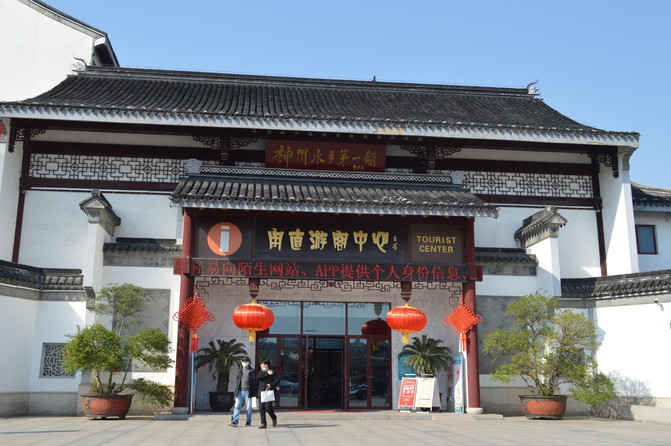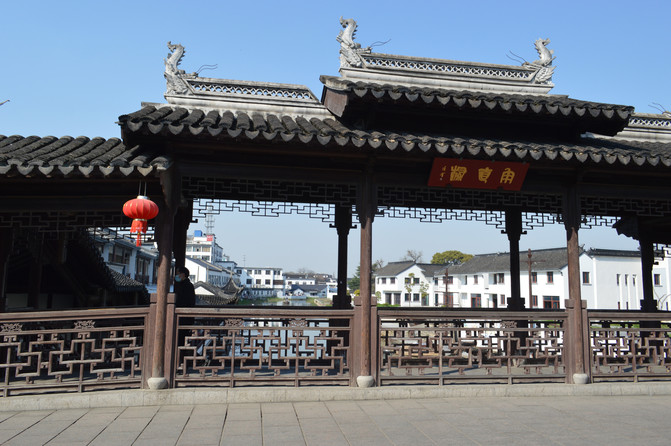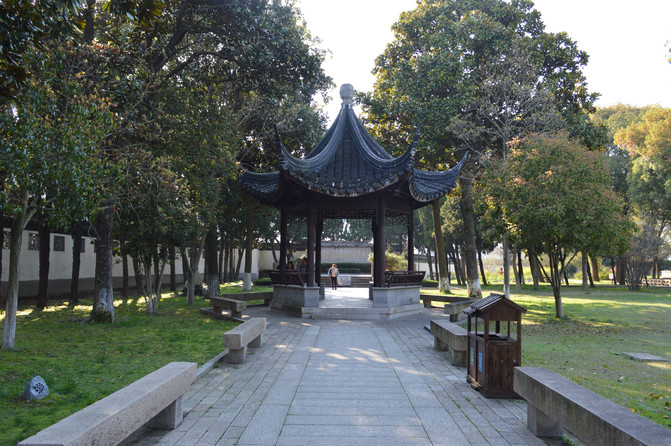Take a look at Luzhi-Baosheng Temple, Ye Shengtao Memorial Hall
Walking time: 2021.3
Walking method: self-driving
Walking route:
D1:
Nanjing--Tongli Ancient Town, Suzhou (Tuisi Garden--Lizze Girls 'School--Wang Shaoao Memorial Hall--Pearl Tower--Chuanxin Lane)
D2:
Tongli Ancient Town, Suzhou (Jiayintang-Chongbentang-Geng Letang-Luoxingzhou)-Tongli Beilian Village-Suzhou Luzhi (Baosheng Temple-Shen Baihan's Former Residence-Mihang-Jiangnan Cultural Park)--Nanjing
After lunch in Tongli, I left, passed by the rapeseed flowers in Beilian Village to stop for photos, and then drove all the way north to Luzhi Ancient Town, 25 kilometers southeast of Suzhou City. We parked our car in the parking lot outside the west gate and walked into the ancient town.

The ticket sales methods in Luzhi Ancient Town and Tongli Ancient Town are different. As long as you enter Tongli, whether you enter those big houses or courtyards or not, you have to buy a ticket for 100 yuan. There is no need for tickets to enter Luzhi Ancient Town. If you just choose to stroll through the ancient town, you can stroll leisurely. If you need to enter more than 10 scenic spots such as Baosheng Temple, Wang Tao Memorial Hall, Shen Zhai, Xiao Fangfang Performing Arts Hall, and Wansheng Rice Shop (including Agricultural Tools Hall), you need to buy a joint ticket. This model is actually more popular among tourists.

Across the Tourist Service Center, there is a spectacular covered bridge, with layered roofs and cornices creating an antique bridge.

There is a stone archway with four pillars and three doors on one side of the square, which can also be regarded as an iconic doorway of the ancient town!

Walking on this covered bridge, the deck is wide, you can drive in the middle, and covered bridges on both sides for pedestrians to walk on. It is not only safe and beautiful, but also has the function of blocking the sun and rain.

The design of the covered bridge is antique and completely consistent with the charm of the ancient town.

Look around on the bridge and see the sparkling scenery. Luzhi is the same age as the ancient city of Suzhou, and its more than 2,500 years of history is rare in Jiangnan.

Water is the soul of Luzhi Ancient Town. This place is located in the Taihu Lake Basin and is known as the "Hall of the Five Lakes" and the "Chong of the Six Swamps".

The ancient town is built next to the water. There are endless water, winding rivers, spotted powder walls, and heavy black tiles. There are thousands of households and hundreds of merchants.

Across the covered bridge is a large scenic square with a large shaded wall on the square.

There are also scenic signs written on stone tablets.

Stone carvings of various divine beasts attract tourists to take photos.


Here is a craft display area about Suzhou's national intangible cultural heritage-cloth dyeing

With the help of several Jiangnan houses with white walls and blue tiles and herringbone roofs, tall cloth drying brackets and several large dyeing vats, the overview of Jiangnan cloth dyeing is shown.

From the square, there are many water-based paths leading into the ancient town. The river is not wide, and the streets and alleys are not large and stretch all the way.

The narrow waterside streets and alleys are lined with small shops and restaurants selling various kinds of goods. They are very lively and exude a strong atmosphere of ancient town culture.


Although this place also has white walls and green tiles like most ancient towns, the structure, layout and details of the eaves of the house still show its unique charm.

The residential buildings are not large in size, but their shapes are unique and well-organized. These houses collect countless beautiful scenery throughout the four seasons.

Look at the door face of this family. The stone decorative windows on both sides of the door face are very artistic.

Luzhi gathers water into a town, and if there is water, there must be bridges. The flowing water and bridges in the ancient town complement each other. At its heyday, there were "seventy-two and a half" ancient bridges of various types in the Song, Yuan, Ming and Qing Dynasties on the river, and 41 of them exist. These bridges vary in size, form and style, making them truly the "bridge capital of water towns".

This Yong 'an Bridge, which spans the Xihui River and connects Xihui Shangtang Street and Xihui Xiatang Street, is a stone arch bridge. The semicircular bridge holes, the rectangular stone strips, and the curved bridge back constitute a very rhythmic beauty.

A few steps further is a granite single-hole arch bridge with a nice name-Xianghua Bridge. The bridge was built in the Qing Dynasty, Yong and Qian Dynasties.

The bridge railings are decorated with stone slabs that leak out, and stone lions are placed at the top of the four pillars on the bridge deck.

Baosheng Temple is at the end of a stone path under the bridge. Standing on the bridge, you can see the yellow wall under the blue eaves, which is Zen and quiet.

On the south side of Xianghua Bridge is Taiwei Lane. Nongbi Street is much cleaner and elegant. Most of them are local residents and there are few shops. If you want to truly feel Luzhi, you can take a walk in these deep and long alleys.

There is a fragrant flower lane on the north side of Xianghua Bridge.

Pass through the fragrant flower lane and come to the door of Baosheng Temple. Baosheng Temple is a famous thousand-year-old temple in Jiangnan. At that time, it had more than 200 buildings and was called one of the four major temples in Jiangnan. The gate of Baosheng Temple today was rebuilt according to its original appearance during the Qianlong period.

There is a garden between the gate and the Tianwang Hall. There are towering ancient trees in the garden and four century-old wolfberry trees, which are quite rare. The garden landscape of rocks and rocks adorns the small courtyard. There is also a relic of the Song Dynasty in the courtyard-"Banner Pole and Stone".

On the west side of the entrance gate is Tingsong Xuan

Mingxiutang

Walking into the Second Gate, I saw the majestic Hall of Tianwang. The Tianwang Hall was rebuilt according to the original appearance of the Ming Dynasty. It has a single-eared mountain roof and a rising eaves style on the corners, showing the style of the Jiangnan Buddha Hall.

Across a small courtyard in the Hall of Kings, the original location of the Daxiong Hall at the other end of the courtyard is now an antiquities museum.

Baosheng Temple Antiquities Museum

There is the world-famous "Plastic Wall Arhat" in the Antiquities Museum. Because there is no habit of taking photos in temples, let's take one like this here!

There is a courtyard north of the Hall of Kings. The corridor on one side of the courtyard displays 16 building foundation columns from the former site of Bailian Temple in the Song Dynasty.


There is an iron clock in the courtyard. The iron bell is not only the mountain treasure of the Buddhist temple, but also a historical witness of the Buddhist temple. This temple bell in Baosheng Temple was cast in the late Ming and early Qing Dynasties and has a history of more than 300 years. The inscriptions on the bell are auspicious words such as "Good weather and good rain" and "Good harvest of grain".

The corridor also displays steles from various dynasties.

In the southwest of Baosheng Temple, there is a Ye Shengtao Memorial Hall surrounded by white walls and blue tiles. On the forehead of the main entrance with the pink walls and black tiles is engraved with Zhao Puchu's inscription on the stone green characters "Ye Shengtao Memorial Hall". This is the former site of "Wu County No. 5 Higher Primary School" where Ye Shengtao taught. In order to express their reverence and nostalgia for Mr. Ye, the people of Luzhi rebuilt the former site where he taught and turned it into the Ye Shengtao Memorial Hall.

A four-sided hall in the courtyard was the exhibition room of the "Five Highs" at that time

The appearance of the four-sided hall is a square pavilion with low cylindrical walls, and the four sides are connected. The pavilion's inner doors and walls are spaced apart to form a small hall.

There is a two-story and four-bay women's building here. Lao Ye's wife also taught in the women's building.

This is the place where Ye Shengtao, a writer, educator, publisher and social activist, worked. Now a row of bungalows has been built here
Ye Shengtao Memorial Hall.

There is a huge Podocarpus tree in front of the memorial hall

The memorial hall is now an exhibition hall for Ye Shengtao's life stories. In the center of the memorial hall is a bust statue of Ye Shengtao, a model teacher of a generation.

The memorial hall mainly uses precious objects, photos and written materials to introduce Ye Lao Guanghui's outstanding achievements and major contributions in education, literature, social activities, etc. from different aspects, especially the educational reform practice carried out during the Luzhi period., literary creation, etc.


Ye Shengtao's deeds exhibition is divided into 8 parts. Among them is a photo of Ye Shengtao taking a group photo with teachers and classmates while studying at Changyuan Wu Public Primary School in 1907. There are also scarves, watches, radios, magnifying glasses, brushes, inkstones, tea sets and other items used by Lao Ye.




Behind the memorial hall is a garden, and in the corner is the former site of Mr. Ye's farm founded at the fifth high school. In the other corner of the garden is Mr. Ye Shengtao's tomb. The tomb was built on a spacious stone platform. A new hexagonal "Weiyan Pavilion" was built on the corridor in front of the tomb.

This is the former site of Ye Shengtao's tomb and teaching office

The mandarin duck hall with a flowing curve on the roof.

"Yuanyang Hall" was the office and dormitory of teachers at that time.

Yuanyang Hall has north and south halls


The south hall is the teachers 'office

Hanging on the wall are the "Luzhi Senior Primary School Manifesto" and "Our Contemporary Awareness" written by Mr. Ye.

Because it was past four o'clock, if you wanted to see more attractions, you had to speed up your pace, so I hurriedly walked around here and left.

There is a square well pavilion in front of Baosheng Temple with cornices at four corners and beautiful curves.

Return to Xihui Shangtang Street, continue east, and go deep into the ancient town to admire it...
Previous Article:More than 60 kilometers away from Shanghai, there is an ancient Jiangnan town hidden in a boudoir. I will recommend it if I visit it
Next Article:Panmen, remembering the history of Wu and Yue at the gate of water and land (Part 1)
